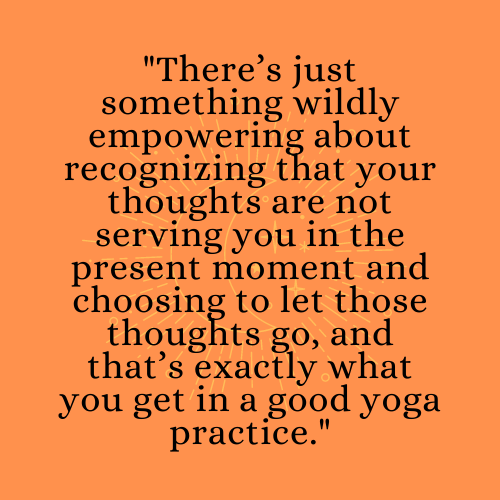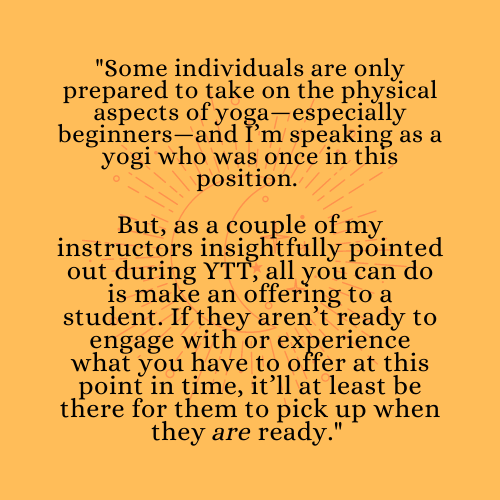I’m Yoga Teacher Certified…Now What?
In mid-February of this year, I completed my first 200 Hour Yoga Teacher Training (YTT) course in Kelowna, British Columbia. I’m officially yoga teacher certified. So, now what? Am I going to teach in studio, online, to friends and family, or maybe just continue to grow my own practice?
Well, it’s actually all of the above: my hope is to teach online in the near future and offer pre-recorded classes on this very website once I get all the business basics worked out; my hope is to teach to all friends and family members who will have me (get at me friends and family members who want an introductory yoga class); my hope is to eventually teach in studio at some point here in British Columbia (when that becomes possible again…curse this pandemic!); and my hope is to continue to grow my own yoga practice each and every day on my own and with other yogis, teachers, and students.
I’m also excited to tell you a bit about my intentions as a yoga teacher and what I want to offer my students. I have three major intentions in mind: to guide classes that focus upon self-empowerment, particularly for women (this is the Little Feminist Movement blog, after all); to guide classes that emphasize compassion toward others and the self; and to guide classes that go beyond the asanas (postures) by incorporating traditional yoga philosophy to help stimulate spiritual growth and understanding.
Here, let me explain.
Self-Empowerment (Particularly for Women)
Speaking as a woman, I find that practicing yoga is one of the most self-empowering things you can do: it makes you stronger physically while also simultaneously strengthening and opening the mind. Yoga is actually the first form of exercise I ever did where I was not necessarily concerned about losing weight or toning up my body (perhaps some other individuals can relate?). Instead, I just wanted to become strong and gain control over my body, which I attribute to the mind-body connection required for yoga.
Although yoga may be represented as such on television and in films, it does not simply consist of sitting on a mat and doing stretches (well, sometimes it does, but that’s not only what it consists of). Just like other forms of exercise, yoga can be challenging; yoga can make you sweat; yoga can make your muscles ache for days afterward. Due to the physical stamina and dedication required, yoga is naturally a very self-empowering practice.

There’s also another layer of physical self-empowerment to yoga since—other than a mat and a few blocks—it doesn’t require any equipment: all of the asanas are just you, your body, and your mind.
And that’s the second form of self-empowerment that comes with practicing yoga: empowering the mind. For instance, while I’m practicing yoga, I often find my mind wandering to all kinds of things—what I did at work earlier in the day, what I’m going to eat for supper, random embarrassing things I did in eighth grade that creep out of my memory bank once in a while—and I have to find the internal strength to pull my mind back to the practice and present moment. There’s just something wildly empowering about recognizing that your thoughts are not serving you in the present moment and choosing to let those thoughts go, and that’s exactly what you get in a good yoga practice.
Compassion Toward Others and the Self
I began to talk about this a bit in the previous section when I mentioned that yoga was the first form of exercise that I did where I wasn’t always concerned about losing weight, and that’s primarily because the practice of yoga taught me to have compassion toward—and eventually love—my body and show gratitude for what it can do rather than resent it for what it cannot do.
Prior to discovering yoga, I had extremely unhealthy relationships with food, exercise, and, quite frankly, myself. If you’re interested in reading about my personal journey of discovering yoga, I talk about it in great detail in my blog post “The Transformative Power of Yoga: Learning to Love My Body.”
Additionally, the practice of yoga does not only encourage you to become compassionate toward yourself but also toward those surrounding you from loved ones to coworkers to complete strangers. The philosophical side of yoga—one of the Yamas, ahimsa, comes to mind, which literally means non-violence—is built upon the ideas of universal compassion and union. This is something that is so important to me that I include in my classes because compassion was something I was lacking in my life for so long: there were times in my life when I was not compassionate toward myself and, unfortunately, not compassionate or kind toward those surrounding me either.
I obviously can’t change the past, but I can practice compassion—and teach my students to practice compassion, too—moving forward.
Spiritual Growth and Understanding
Spiritual growth and understanding have overtaken my own life lately, and I’d love to be able to offer space to promote similar growth and understanding in my students. In order to do this, my intention is to honour traditional yoga philosophies, as well as the Sanskrit language itself, by incorporating them into my classes. For example—since I already mentioned one of the Yamas, ahimsa, I might as well use it as an example here, too—I might theme a class around the concept of ahimsa, share a passage or a quotation about ahimsa to help explain the concept to students, or perhaps even create a playlist for a class that reflects ahimsa. One could do this with any aspect of yoga philosophy, really: the Yamas, Niyamas, the chakra energy system, one of the Yoga Sutras, or any of the traditional yogic texts.

The traditional, spiritual, and philosophical aspects of yoga are so new to me but so foundational to the practice. I want to be able to share what I’m learning and experiencing with my students, and I feel that the best way to do this is to incorporate these aspects of yoga into my classes right from the beginning. I realize, though, that spirituality and growth look very different for every individual. Some individuals are only prepared to take on the physical aspects of yoga—especially beginners—and I’m speaking as a yogi who was once in this position.
But, as a couple of my instructors insightfully pointed out during YTT, all you can do is make an offering to a student. If they aren’t ready to engage with or experience what you have to offer at this point in time, it’ll at least be there for them to pick up when they are ready.